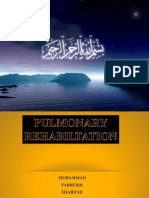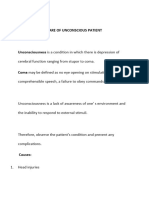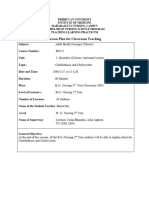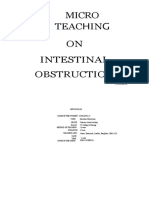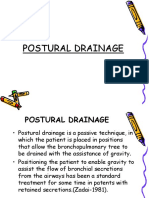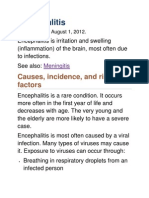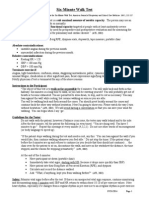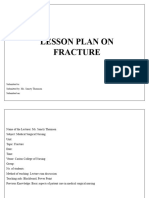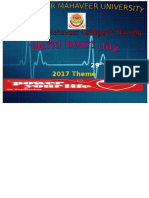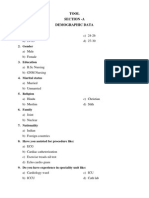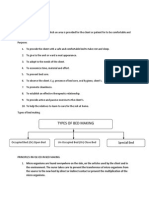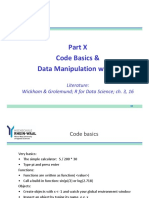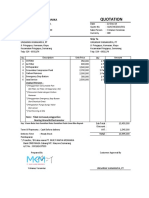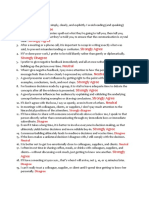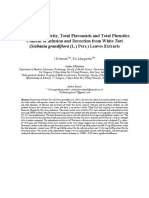0 ratings0% found this document useful (0 votes)
431 viewsChest Physiotherapy
Chest Physiotherapy
Uploaded by
tetarwalChest physiotherapy involves techniques to clear secretions from the lungs and airways, especially for patients with large amounts of secretions or ineffective coughing. It includes maneuvers like chest percussion, postural drainage, and vibration to mobilize secretions so they can be cleared. Common indications are cystic fibrosis, bronchiectasis, pneumonia, and neuromuscular diseases. Techniques involve positioning the patient and using percussion or vibration over affected areas of the lungs while the patient exhales to loosen and drain secretions.
Copyright:
© All Rights Reserved
Available Formats
Download as DOCX, PDF, TXT or read online from Scribd
Chest Physiotherapy
Chest Physiotherapy
Uploaded by
tetarwal0 ratings0% found this document useful (0 votes)
431 views8 pagesChest physiotherapy involves techniques to clear secretions from the lungs and airways, especially for patients with large amounts of secretions or ineffective coughing. It includes maneuvers like chest percussion, postural drainage, and vibration to mobilize secretions so they can be cleared. Common indications are cystic fibrosis, bronchiectasis, pneumonia, and neuromuscular diseases. Techniques involve positioning the patient and using percussion or vibration over affected areas of the lungs while the patient exhales to loosen and drain secretions.
Original Description:
notes for chest physiotherapy
Copyright
© © All Rights Reserved
Available Formats
DOCX, PDF, TXT or read online from Scribd
Share this document
Did you find this document useful?
Is this content inappropriate?
Chest physiotherapy involves techniques to clear secretions from the lungs and airways, especially for patients with large amounts of secretions or ineffective coughing. It includes maneuvers like chest percussion, postural drainage, and vibration to mobilize secretions so they can be cleared. Common indications are cystic fibrosis, bronchiectasis, pneumonia, and neuromuscular diseases. Techniques involve positioning the patient and using percussion or vibration over affected areas of the lungs while the patient exhales to loosen and drain secretions.
Copyright:
© All Rights Reserved
Available Formats
Download as DOCX, PDF, TXT or read online from Scribd
Download as docx, pdf, or txt
0 ratings0% found this document useful (0 votes)
431 views8 pagesChest Physiotherapy
Chest Physiotherapy
Uploaded by
tetarwalChest physiotherapy involves techniques to clear secretions from the lungs and airways, especially for patients with large amounts of secretions or ineffective coughing. It includes maneuvers like chest percussion, postural drainage, and vibration to mobilize secretions so they can be cleared. Common indications are cystic fibrosis, bronchiectasis, pneumonia, and neuromuscular diseases. Techniques involve positioning the patient and using percussion or vibration over affected areas of the lungs while the patient exhales to loosen and drain secretions.
Copyright:
© All Rights Reserved
Available Formats
Download as DOCX, PDF, TXT or read online from Scribd
Download as docx, pdf, or txt
You are on page 1of 8
Chest physiotherapy (CPT)
This page was last updated on February 13, 2011
Definition
Chest physiotherapy (CPT) is a technique used to mobilize or loose secretions in the
lungs and respiratory tract.
This is especially helpful for patients with large amount of secretions or ineffective
cough.
Chest physiotherapy consists of external mechanical maneuvers, such as chest
percussion, postural drainage, vibration, to augment mobilization and clearance of airway
secretions, diaphragmatic breathing with pursed-lips, coughing and controlled coughing.
Anatomy and physiology of respiratory system
Lungs are the main organs of the respiratory system.
The lungs are located inside the upper part of our chest on either side of the heart, and
they are protected by the ribcage.
The breastbone (sternum) is at the center front of the chest, and the spine is at the center
of the back of the chest.
The inside of the chest cavity and the outside of the lungs are covered by the pleura, a
slippery membrane that allows the lungs to move smoothly as they fill up with and empty
out air when we inhale and exhale.
Normally, there is a small amount of lubricating fluid between the two layers of the
pleura.
This helps the lungs glide inside the chest as they change size and shape during breathing.
Air moves through the body in the following order:
Nostrils
Nasal cavity
Pharynx (naso-, oro-, laryngo-)
Larynx (voice box)
Trachea (wind pipe)
Thoracic cavity (chest)
Bronchi (right and left)
Alveoli (site of gas exchange)
Divisiond of the Trachea & Bronchi
The trachea leads down to the thoracic cavity (chest) where it divides into the right and
left "main stem" bronchi.
The subdivisions of the bronchus are: primary, secondary, and tertiary divisions (first,
second and third levels).
In all, they divide 16 more times into even smaller bronchioles. The bronchioles lead to
the respiratory zone of the lungs, which consists of respiratory bronchioles, alveolar ducts
and the alveoli, the multi-lobulated sacs in which most of the gas exchange occurs.
The right lung is composed of three lobes: the upper lobe, the middle lobe and the lower
lobe.
The left lung is made up of only two lobes: the upper lobe and the lower lobe.
Lobes & Divisions of the lungs
The lobes are divided into smaller divisions called segments.
The upper lobes on the left and right sides are each made up of three segments: apical,
posterior and anterior.
The left upper lobe includes the lingual, which corresponds to the middle lobe on the
right.
The lower lobes each include four segments: superior, anterior, basal, lateral basal
and posterior basal.
Each segment of the lung contains a network of air tubes, air sacs and blood vessels.
These sacs allow for the exchange of oxygen and carbon dioxide between the blood and
air. It is these segments that are being drained.
Physiology of Respiration
Inhalation
Inhalation is initiated by the diaphragm and supported by the external intercostal muscles.
Normal resting respirations are 10 to 18 breaths per minute. Its time period is 2 seconds.
Inhalation is primarily driven by the diaphragm and accessory muscles.
When the diaphragm contracts, the ribcage expands and the contents of the abdomen are
moved downward.
This results in a larger thoracic volume, which in turn causes a decrease in intrathoracic
pressure.
As the pressure in the chest falls, air moves into the conducting zone. Here, the air is
filtered, warmed, and humidified as it flows to the lungs
Exhalation
Exhalation is generally a passive process, however active or forced exhalation is achieved
by the abdominal and the internal intercostal muscles.
The lungs have a natural elasticity; as they recoil from the stretch of inhalation, air flows
back out until the pressures in the chest and the atmosphere reach equilibrium.
During forced exhalation, as when blowing out a candle, expiratory muscles including the
abdominal muscles and internal intercostal muscles, generate abdominal and thoracic
pressure, which forces air out of the lungs.
Gas Exchange
The major function of the respiratory system is gas exchange.
Upon inhalation, gas exchange occurs at the alveoli, the tiny sacs which are the basic
functional component of the lungs.
The alveolar walls are extremely thin, and are permeable to gases.
The alveoli are lined with pulmonary capillaries, the walls of which are also thin enough
to permit gas exchange.
All gases diffuse from the alveolar air to the blood in the pulmonary capillaries, as carbon
dioxide diffuses in the opposite direction, from capillary blood to alveolar air.
Now, the pulmonary blood is oxygen-rich, and the lungs are holding carbon dioxide.
Exhalation follows, thereby ridding the body of the carbon dioxide and completing the
cycle of respiration.
In an average resting adult, the lungs take up about 250ml of oxygen every minute while
excreting about 200ml of carbon dioxide.
During an average breath, an adult will exchange from 500 ml to 700 ml of air. This,
average breath capacity is called tidal volume.
Indications of Chest Physiotherapy
It is indicated for patients in whom cough is insufficient to clear thick, tenacious, or localized
secretions. Examples include:
Cystic fibrosis
Bronchiectasis
Atelctasis
Lung abscess
Neuromuscular diseases
Pneumonias in dependent lung regions.
Contraindications of Chest Physiotherapy
Increased ICP
Unstable head or neck injury
Active hemorrhage with hemodynamic instability or hemoptysis
Recent spinal injury or injury
Empyma
Bronchoplueral fistula
Rib fracture
Fail chest
Uncontrolled hypertension
Anticoagulation
Rib or vertebral fractures or osteoporosis
Assessment for Chest Physiotherapy
Nursing care and selection of CPT skills are based on specific assessment findings. The
following are the assessment criteria:
Know the normal range of patients vital signs. Conditions requiring CPT, such
atelectasis, and pneumonia, affects vital signs.
Know the patients medications. Certain medications, particularly diuretics
antihypertensive cause fluid and haemodynamic changes. These decrease patients
tolerance to positional changes and postural drainage.
Know the patients medical history; certain conditions such as increased ICP, spinal
cord injuries and abdominal aneurysm resection, contra indicate the positional change to
postural drainage. Thoracic trauma and chest surgeries also contraindicate percussion and
vibration.
Know the patients cognitive level of functioning. Participating in controlled cough
techniques requires the patient to follow instructions.
Beware of patients exercise tolerance. CPT maneuvers are fatiguing. Gradual
increase in activity and through CPT, patient tolerance to the procedure improves.
Clinical findings and investigations
Detailed History
Physical examination
Inspection
Palpation
Percussion
Auscultation
Investigations
X-ray
Blood investigations-bleeding and clotting parameters
Techniques in Chest Physiotherapy
A nurse or respiratory therapist may administer CPT, although the techniques can often
be taught to family members of patients.
The most common procedures used are postural drainage and chest percussion, in which
the patient is rotated to facilitate drainage of secretions from a specific lobe or segment
while being clapped with cupped hands to loosen and mobilize retained secretions that
can then be expectorated or drained.
The procedure is somewhat uncomfortable and tiring for the patient.
1. Percussion
Chest percussion involves striking the chest wall over the area being drained.
Percussing lung areas involves the use of cupped palm to loosen pulmonary secretions so
that hey can be expectorated with ease.
Percussing with the hand held in a rigid dome-shaped position, the area over the lung
lobes to be drained in struck in rhythmic pattern.
Usually the patient will be positioned in supine or prone and should not experience any
pain.
Cupping is never done on bare skin or performed over surgical incisions, below the ribs,
or over the spine or breasts because of the danger o tissue damage.
Typically, each area is percussed for 30 to 6oseconds several times a day.
If the patient has tenacious secretions, the area must be percussed for 3-5 minutes several
times per day. Patients may learn how to percuss the anterior chest as well.
2. Vibration
In vibration, the nurse uses rhythmic contractions and relaxations is or her arm and
shoulder muscles while holding thee patient flat on the patients chest as the patient
exhales.
The purpose is to help loosen respiratory secretions so that they can be expectorated with
ease. Vibration (at a rate of 200 per minute) can be done for several times a day.
To avoid patient causing discomfort, vibration is never done over the patients breasts,
spine, sternum, and rib cage.
Vibration can also be taught to family members or accomplished with mechanical device.
Procedure: Percussion & Vibration
Instruct the patient use diaphragmatic breathing
Position the patient in prescribed postural drainage positions. Spine should be straight to
promote rib cage expansion
Percuss or clap with cupped hands or chest wall for 5 minutes over each segment for 5
minutes for cystic fibrosis and 1-2 minutes for other conditions
Avoid clapping over spine, liver, spleen, breast, scapula, clavicle or sternum
Instruct the patient to inhale slowly and deeply. Vibrate the chest wall as the patient
exhales slowly through the pursed lips.
Place one hand on top of the other affected over area or place one hand place one and on
each side of the rib cage.
Tense the muscles of the hands and hands while applying moderate pressure downward
and vibrate arms and hands
Relieve pressure on the thorax as the patient inhales.
Encourage the patient cough, using abdominal muscles, after three or four vibrations.
Allow the patient rest several times
Listen with stethoscope for changes in breath sounds
Repeat the percussion and vibration cycle according to the patients tolerance and clinical
response: usually 15-30 minutes.
3. Postural Drainage
Postural drainage is the positioning techniques that drain secretions from specific
segments of the lugs and bronchi into the trachea.
Because some patients do not require postural drainage for all lung segments, the
procedure must be based on the clinical findings.
In postural drainage, the person is tilted or propped at an angle to help drain secretions
from the lungs.
Also, the chest or back may be clapped with a cupped hand to help loosen secretions
the technique called chest percussion.
Postural drainage cannot be used for people who are:
o unable to tolerate the position required,
o are taking anticoagulation drugs,
o have recently vomited up blood,
o have had a recent rib or vertebral fracture, or
o have severe osteoporosis.
Postural drainage also cannot be used for people who are unable to produce any
secretions (because when this happens, further attempts at postural drainage may lower
the level of oxygen in the blood).
Procedure
The patient's body is positioned so that the trachea is inclined downward and below the
affected chest area.
Postural drainage is essential in treating bronchiectasis and patients must receive
physiotherapy to learn to tip themselves into a position in which the lobe to be drained is
uppermost at least three times daily for 10-20 minutes.
The treatment is often used in conjunction with the technique for loosening secretions in
the chest cavity called chest percussion.
Articles required
Pillows
Tilt table
Sputum cup
Paper tissues
Steps
1. Use specific positions so the force of gravity can assist in the removal of bronchial
secretions from affected lung segments to central airways by means of coughing and
suctioning.
2. The patient is positioned so that the diseased area is in a near vertical position, and
gravity is used to assist the drainage of specific segment.
3. The positions assumed are determined by the location, severity, and duration of mucous
obstruction
4. The exercises are performed two to three times a day, before meals and bedtime. Each
position is done for 3-15 minutes
5. The procedure should be discontinued if tachycardia, palpitations, dyspnea, or chest
occurs. The se symptoms may indicate hypoxemia. Discontinue if hemoptysis occurs.
6. Bronchodilators, mucolytics agents, water, or saline may be nebulised and inhaled before
postural drainage and chest percussion to reduce bronchospasm, decrease thickness of
mucus and sputum, and combat edema of the bronchial walls, there by enhancing
secretion removal
7. Perform secretion removal procedures before eating
8. Make sure patient is comfortable before the procedure starts and as comfortable as
possible he or she assumes each position
9. Auscultate the chest to determine the areas of needed drainage
10. Encourage the patient to deep breathe and cough after spending the allotted time in each
position.
11. Encourage diaphragmatic breathing through out postural drainage: this helps widen
airways so secretions can be drained
Positions
ADULT
Lung segment Position recommended
Bilateral High Fowlers
Apical-right upper lobe-
anterior segment
Sitting on side of the bed
Supine with head elevated
Left upper lobe-anterior Supine with head elevated
Right upper lobe-posterior Side-lying with right side of the
chest elevated on pillows
Left upper lobe-posterior Side-lying with left side of the
chest elevated on pillows
Right Middle lobe-anterior
segment
Three-fourth supine position
with dependent lung in
Trendelenburgs position
Right Middle lobe-posterior
segment
Prone with thorax and abdomen
elevated
Both lower lobes-anterior
segments
Supine in Trendelenburgs
position
Left lower lobe lateral
position
Right side-lying in
Trendelenburgs position
Right lower lobe-lateral
segment
Left side-lying in
Trendelenburgs position
Right lower lobe-posterior
segment
Prone with right side of chest
elevated in Trendelenburgs
position
Both lower lobes-posterior
segment
Prone in Trendelenburgs
position
CHILD
Bilateral-Apical segments Sitting on nurses lap, leaning
slightly forward flexed over
pillow.
Bilateral-middle anterior
segments
Sitting on nurses lap, leaning
against nurse
Bilateral- anterior segments Lying supine on nurses lap,
back supported with pillow.
Complications
Complications are unusual but include:
position-related hypoxia
aspiration of secretions in other lung regions
hypotension
4. Coughing
coughing gently or making short grunting noises with the mouth slightly open will help
loosen the mucus.
Do this periodically throughout the drainage procedure.
5. Controlled Coughing Technique
Controlled coughing is one of the essential techniques in good respiratory care.
Patient perform this maneuver after each drainage position and often throughout the day.
The abdominal muscles are very powerful muscles used in coughing and exhaling.
Inhale deeply through the nose.
Pause.
Cough 2 to 3 sharp staccato cough with proper hand/arm placement.
Breathe in easily through the nose.
Conclusion
Chest physiotherapy is an effective procedure in chronic pulmonary disorders. This is especially
helpful for patients with large amount of secretions or ineffective cough. It is performed by
professionally trained nurses in most settings.
References
1. Potter Perry. Basic Nursing 6th edn..Mosbi, Missouri, 2006.
2. Carel TylerCarel Lilli, Pricilla Lemone. Fundamentals of Nursing. Lippincotts Williams
Philadelphia, 2006
3. Judson, MA, Sahn, SA (1994) Mobilization of secretions in ICU patients. Respir Care
39,213-226.
4. Wallis C., Prasad A. Who needs CPT? Moving from anecdote to evidence. Arch Dis
Child 1999; 80:393-397.
5. Fedorovich C; Littleton MT. Chest physiotherapy: evaluating the effectiveness.
Dimensions of Critical Care Nursing (DCCN), 1990 Mar-Apr; 9(2): 68-7
You might also like
- Pulmo Rehab Phase 2Document65 pagesPulmo Rehab Phase 2Farrukh ShahzadNo ratings yet
- HW04 - Equil 1-SolutionsDocument4 pagesHW04 - Equil 1-SolutionsKeerthana KumarNo ratings yet
- Chest PhysiotherapyDocument13 pagesChest PhysiotherapyAlma Susan100% (1)
- Chest Physiotherapy - Postural DrainageDocument2 pagesChest Physiotherapy - Postural DrainageMicah MagallanoNo ratings yet
- Case Study On Head InjuryDocument15 pagesCase Study On Head InjuryPriya SinghNo ratings yet
- A Lumbar PunctureDocument6 pagesA Lumbar PunctureNivinj KennedyNo ratings yet
- Pulmonary Function Test: By: Alfaro, Ruby Jane SDocument13 pagesPulmonary Function Test: By: Alfaro, Ruby Jane SgjevamNo ratings yet
- Breathing ExercisesDocument19 pagesBreathing ExercisesvarunNo ratings yet
- 18.abdominal InjuryDocument5 pages18.abdominal InjuryPriyaNo ratings yet
- Cardiovascular System Diseases Part 2Document9 pagesCardiovascular System Diseases Part 2Prince Rener Velasco PeraNo ratings yet
- Therapy (LLL)Document432 pagesTherapy (LLL)Biruk DesalegnNo ratings yet
- Pulmonary Function TestsDocument7 pagesPulmonary Function Testspragna novaNo ratings yet
- Spinal Cord InjuriesDocument109 pagesSpinal Cord InjuriesGurinder GillNo ratings yet
- Percussion 2. Vibration 3. ShakingDocument2 pagesPercussion 2. Vibration 3. ShakingMokibulNo ratings yet
- Angina PectorisDocument7 pagesAngina PectorisTruptilata SahooNo ratings yet
- Care of Unconscious PatientDocument7 pagesCare of Unconscious PatientSallieNo ratings yet
- Postural DrainageDocument7 pagesPostural DrainagemohtishimNo ratings yet
- Oxygen AdministrationDocument15 pagesOxygen AdministrationMayank KumarNo ratings yet
- TracheostomyDocument31 pagesTracheostomyTonyScaria100% (1)
- Presentation EpilepsyDocument38 pagesPresentation EpilepsypertinenteNo ratings yet
- Lesson PlanDocument15 pagesLesson PlanAnisha SalujaNo ratings yet
- Cholelithiasis - 4th Class Binita DasDocument13 pagesCholelithiasis - 4th Class Binita DasRanjit SahNo ratings yet
- MSC Lesson PlanDocument32 pagesMSC Lesson PlanDedeepya YendrapatiNo ratings yet
- Thoracotomy: T.Sunil KumarDocument59 pagesThoracotomy: T.Sunil KumarYamini ChowdaryNo ratings yet
- Vital Signs-Assignment-Fernandez, RR12Document2 pagesVital Signs-Assignment-Fernandez, RR12Veronica ShaneNo ratings yet
- Tracheostomy: S.No: Time Specific Objective Content Teachin G Activity Learning Activity Av Aids EvaluationDocument13 pagesTracheostomy: S.No: Time Specific Objective Content Teachin G Activity Learning Activity Av Aids EvaluationaparnaNo ratings yet
- Back CareDocument56 pagesBack CareSandeep Maan100% (2)
- Burn RehabilitationDocument4 pagesBurn RehabilitationSuneel Kumar PrajapatiNo ratings yet
- Cardiopulmonary ResuscitationDocument18 pagesCardiopulmonary ResuscitationNdor Baribolo100% (1)
- Seminar On PoisoningDocument93 pagesSeminar On Poisoningsushmitabiswas052No ratings yet
- BIOPSYDocument8 pagesBIOPSYASHLEY DAWN BUENAFENo ratings yet
- Postural DrainageDocument19 pagesPostural DrainageAtul SrivastavaNo ratings yet
- Respiratory Rate and Breathing Pattern: Clinical ReviewDocument3 pagesRespiratory Rate and Breathing Pattern: Clinical ReviewMochamad BilalNo ratings yet
- Thoracic Surgery LobectomyDocument21 pagesThoracic Surgery LobectomyJane SharpsNo ratings yet
- Respiratory Arrest and InsufficiencyDocument6 pagesRespiratory Arrest and InsufficiencyGetom Ngukir100% (1)
- Lesson Plan BLSDocument10 pagesLesson Plan BLSJoseph carl BañariaNo ratings yet
- Endotracheal Tube IntubationDocument5 pagesEndotracheal Tube IntubationKim Kristine D. GuillenNo ratings yet
- Final Hernioplasty Compilation RevisedDocument58 pagesFinal Hernioplasty Compilation RevisedRaidis PangilinanNo ratings yet
- Ards PDFDocument2 pagesArds PDFgireeshsachinNo ratings yet
- Endotracheal IntubationDocument5 pagesEndotracheal Intubationpriyanka bhavsarNo ratings yet
- Physical Therapy in Critically Ill Adult Patients PDFDocument17 pagesPhysical Therapy in Critically Ill Adult Patients PDFSoledad Cayupi TrafilafNo ratings yet
- Pulmonary Function TestsDocument2 pagesPulmonary Function TestsSafuan Sudin100% (1)
- Ure Thro CeleDocument3 pagesUre Thro CeleKusum RoyNo ratings yet
- Musculoskeletal SystemDocument19 pagesMusculoskeletal SystemDani Anyika100% (1)
- AppendicitisDocument36 pagesAppendicitisPetro MyronovNo ratings yet
- Oxygen Insufficiency.Document54 pagesOxygen Insufficiency.Josephine George Jojo100% (1)
- Assessment of The Nervous SystemDocument49 pagesAssessment of The Nervous Systemnovita100% (1)
- Encephalitis: Causes, Incidence, and Risk FactorsDocument20 pagesEncephalitis: Causes, Incidence, and Risk FactorsClaire Esic PontanarNo ratings yet
- Medscape Status EpilepticusDocument10 pagesMedscape Status EpilepticusEllen Siska SusantiNo ratings yet
- Assignment On Neurological AssessmentDocument20 pagesAssignment On Neurological AssessmentSumandeep KaurNo ratings yet
- A Study To Assess The Effect o 231021 102014Document139 pagesA Study To Assess The Effect o 231021 102014Muhammad Ghifar Nasyith Ramadhan 1D3A100% (1)
- BurnsDocument44 pagesBurnsJANARTHANAN VNo ratings yet
- Procedure Demonstration On Postural DrainageDocument15 pagesProcedure Demonstration On Postural DrainageParth VasaveNo ratings yet
- 6 Minute Walk TestDocument3 pages6 Minute Walk Testrk_s7No ratings yet
- FractureDocument22 pagesFracturenobelaugustineNo ratings yet
- Introduction Definition: Types of PacemakersDocument8 pagesIntroduction Definition: Types of PacemakersPrasann RoyNo ratings yet
- Chest Tube InsertionDocument2 pagesChest Tube InsertionmusicaBGNo ratings yet
- Part I: IntroductionDocument4 pagesPart I: IntroductionChezka PalolaNo ratings yet
- What Is Epilepsy?Document10 pagesWhat Is Epilepsy?RegineCuasSulibNo ratings yet
- Ventricular Septal Defect, A Simple Guide To The Condition, Treatment And Related ConditionsFrom EverandVentricular Septal Defect, A Simple Guide To The Condition, Treatment And Related ConditionsNo ratings yet
- Acute Respiratory Distress Syndrome, A Simple Guide To The Condition, Diagnosis, Treatment And Related ConditionsFrom EverandAcute Respiratory Distress Syndrome, A Simple Guide To The Condition, Diagnosis, Treatment And Related ConditionsNo ratings yet
- Organ Donation in IndiaDocument67 pagesOrgan Donation in Indiatetarwal100% (1)
- 29th SeptemberDocument2 pages29th SeptembertetarwalNo ratings yet
- Cultural UniformityDocument6 pagesCultural Uniformitytetarwal67% (6)
- Events Venue: Indoor Stadium, TMU Campus: Principal and Faculty College of NursingDocument5 pagesEvents Venue: Indoor Stadium, TMU Campus: Principal and Faculty College of NursingtetarwalNo ratings yet
- Cultural UniformityDocument6 pagesCultural Uniformitytetarwal67% (6)
- Tool Section - A Demographic Data: 1. Age in YearsDocument2 pagesTool Section - A Demographic Data: 1. Age in YearstetarwalNo ratings yet
- Nursing Abbreviations: ABBREVIATIONS Are The Shorthand of The Health Professions. They Are Clear and EfficientDocument9 pagesNursing Abbreviations: ABBREVIATIONS Are The Shorthand of The Health Professions. They Are Clear and EfficienttetarwalNo ratings yet
- Check ListDocument11 pagesCheck ListtetarwalNo ratings yet
- Types of Bed Making: Occupied Bed (Or) Open Bed Un Occupied Bed (Or) Close BedDocument1 pageTypes of Bed Making: Occupied Bed (Or) Open Bed Un Occupied Bed (Or) Close BedtetarwalNo ratings yet
- Calculation 2Document13 pagesCalculation 2tetarwal100% (1)
- Approved Topics - 6th BatchDocument5 pagesApproved Topics - 6th Batchtetarwal0% (1)
- Shape FuncDocument33 pagesShape FuncSAMNo ratings yet
- Chandi Sapthasathi RahasyaDocument12 pagesChandi Sapthasathi RahasyaAnonymous VdXFPOvGxNo ratings yet
- Group Members: Bettega Davide Birleanu Raluca Costiuc Alexandra D'Alessandro Antonio Rusu RalucaDocument19 pagesGroup Members: Bettega Davide Birleanu Raluca Costiuc Alexandra D'Alessandro Antonio Rusu Ralucaalexandracostiucale0% (1)
- Code Basics & Data Manipulation With R: Literature: Wickham & Grolemund R For Data Science Ch. 3, 16Document31 pagesCode Basics & Data Manipulation With R: Literature: Wickham & Grolemund R For Data Science Ch. 3, 16Ahsan JavedNo ratings yet
- Pascual vs. Hon. Provincial Board of Nueva Ecija (106 Phil 466), States ThatDocument1 pagePascual vs. Hon. Provincial Board of Nueva Ecija (106 Phil 466), States ThatMarilou AgustinNo ratings yet
- Lesson 10 - What - S Your PersonalityDocument21 pagesLesson 10 - What - S Your PersonalityLOVELY DELA CERNA50% (2)
- Organometallic ChemistryDocument24 pagesOrganometallic ChemistryFatma TaherNo ratings yet
- FTIR SpectrosDocument7 pagesFTIR SpectrosI. Murali KrishnaNo ratings yet
- Kloppers Critical 2003 PDFDocument363 pagesKloppers Critical 2003 PDF조기현No ratings yet
- Q4 Structural EngineerDocument4 pagesQ4 Structural Engineerpaul machariaNo ratings yet
- Screenshot 2022-08-03 at 12.03.23 PMDocument12 pagesScreenshot 2022-08-03 at 12.03.23 PMAbhishekSaxenaNo ratings yet
- Ss English f5 2010Document10 pagesSs English f5 2010Ratinamala Kanaga SundaramNo ratings yet
- Article 335 of RPCDocument2 pagesArticle 335 of RPCLizzeMaeCagasTagataNo ratings yet
- Pendekatan Psikologi Dalam KomunikasiDocument41 pagesPendekatan Psikologi Dalam Komunikasia194660No ratings yet
- Effectiveness of Online Instruction in Technology and Livelihood Education Among Grade 7 StudentsDocument32 pagesEffectiveness of Online Instruction in Technology and Livelihood Education Among Grade 7 StudentsNexPlaysMCNo ratings yet
- SAT - An Overview of The SAT 9 TestDocument172 pagesSAT - An Overview of The SAT 9 Testsakaldoopar100% (1)
- PT. Ungaran WanakaryaDocument2 pagesPT. Ungaran WanakaryaPrince NeroNo ratings yet
- Full Thesis SMIS 2018 19Document50 pagesFull Thesis SMIS 2018 19Jomar RebuladoNo ratings yet
- Agree Strongly Agree Strongly Agree Strongly Disagree Neutral Neutral Strongly Agree Strongly Agree Strongly Agree NeutralDocument3 pagesAgree Strongly Agree Strongly Agree Strongly Disagree Neutral Neutral Strongly Agree Strongly Agree Strongly Agree NeutralFernanda RoldanNo ratings yet
- Aromatherapy For CatsDocument2 pagesAromatherapy For Catsgemma_liñánNo ratings yet
- Evidence - Sy 2020-2021.module IDocument4 pagesEvidence - Sy 2020-2021.module IVanessa Omnas PadillaNo ratings yet
- Quality Lifecycle Management by Karen Bowman PTCDocument3 pagesQuality Lifecycle Management by Karen Bowman PTCFirdaus TahirNo ratings yet
- CL01 Defining Classifying Project Management MethodologiesDocument9 pagesCL01 Defining Classifying Project Management MethodologiesCesar BasualdoNo ratings yet
- Instant Access to Childhood Disability, Advocacy, and Inclusion in the Caribbean: A Trinidad and Tobago Case Study Beth Harry ebook Full ChaptersDocument65 pagesInstant Access to Childhood Disability, Advocacy, and Inclusion in the Caribbean: A Trinidad and Tobago Case Study Beth Harry ebook Full Chapterslouroslawong100% (3)
- Application of Suchman TheoryDocument5 pagesApplication of Suchman TheoryAnusha VergheseNo ratings yet
- Purusha Sukta SaramshamDocument8 pagesPurusha Sukta SaramshamRamanuja Dasan AkkNo ratings yet
- AIPCP AbstractDocument1 pageAIPCP AbstractJmltr RhmhNo ratings yet
- TAFJ-DB SetupDocument21 pagesTAFJ-DB SetuptayutaNo ratings yet
- Stylistics 1Document20 pagesStylistics 1Khrystyna MalyshNo ratings yet
